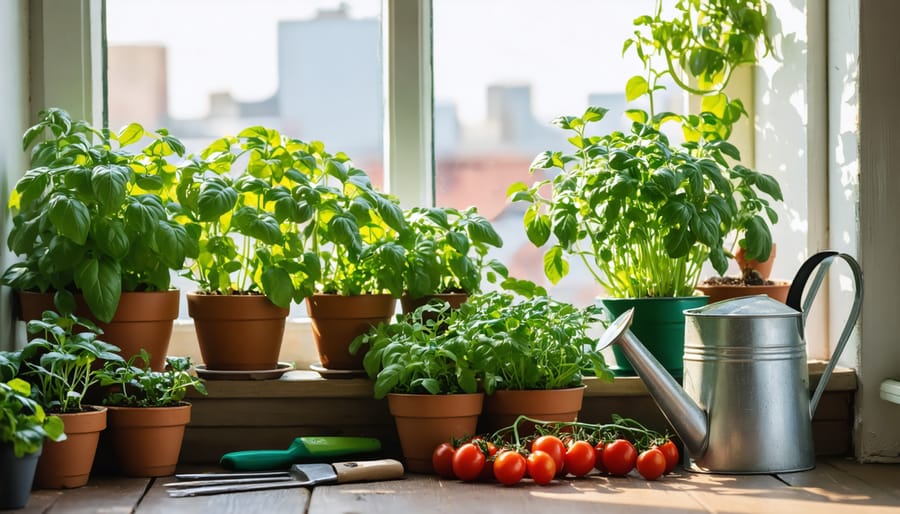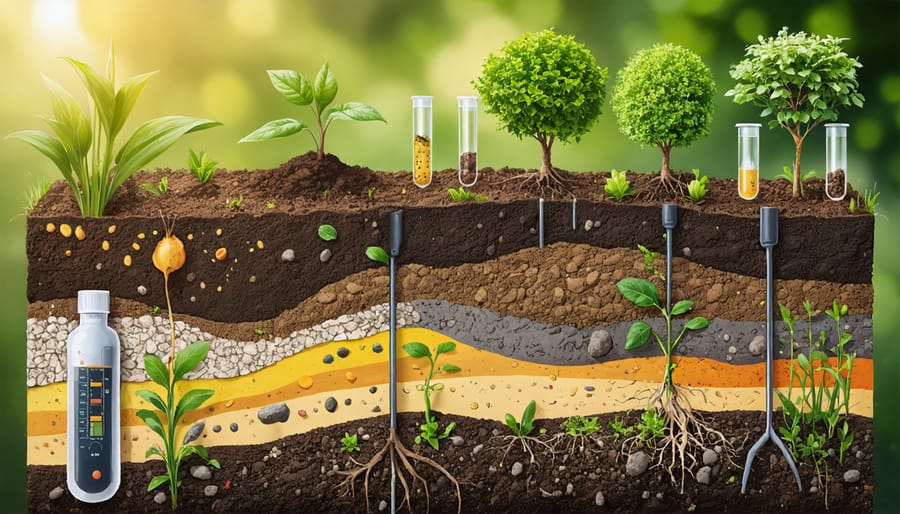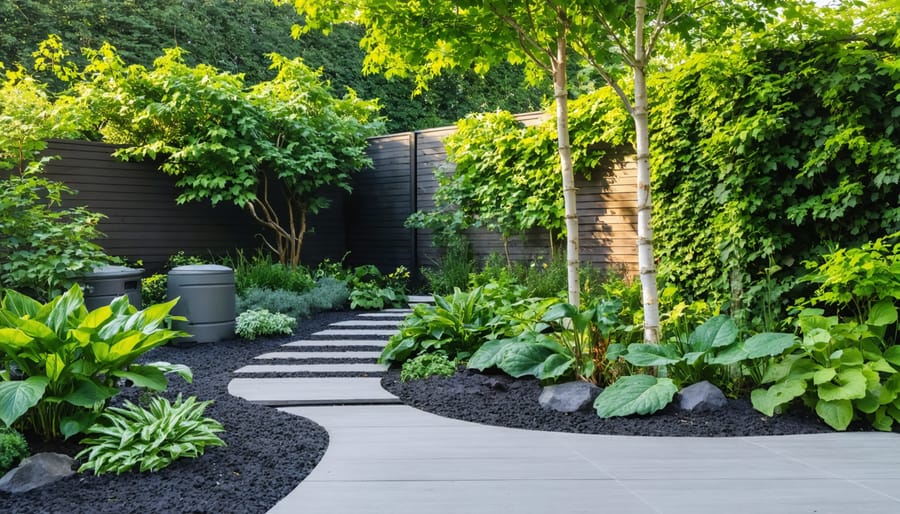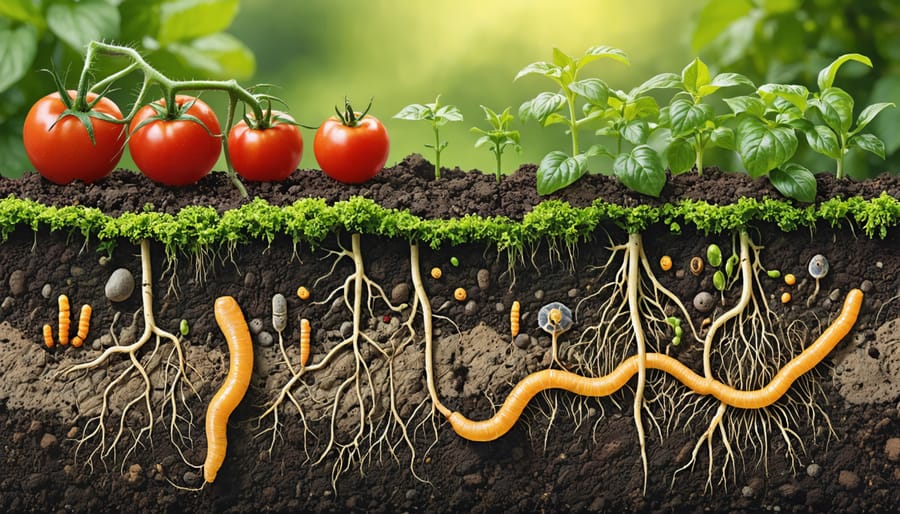Transform any sunny windowsill or empty corner into a thriving indoor garden, even in the depths of winter or cramped urban spaces. Starting an indoor garden opens up year-round growing possibilities while providing fresh herbs, vegetables, and vibrant greenery to brighten your living space. With just a few basic supplies – quality potting soil, proper containers with drainage holes, and a reliable light source – you can create a flourishing indoor garden that produces fresh harvests throughout the year.
Begin by selecting easy-to-grow plants like herbs (basil, mint, parsley), leafy greens (lettuce, spinach), or compact vegetables (cherry tomatoes, microgreens) that thrive in indoor conditions. Position your plants near south-facing windows for natural light, or invest in affordable LED grow lights to provide consistent illumination. Monitor moisture levels carefully – indoor plants typically need less water than outdoor gardens, and proper drainage prevents root rot while maintaining healthy growth.
Whether you’re looking to supplement your grocery shopping with homegrown produce or simply want to add natural beauty to your living space, indoor gardening offers an accessible entry point to the rewarding world of plant cultivation. The controlled environment eliminates weather concerns and extends the growing season indefinitely, making it perfect for both novice gardeners and experienced green thumbs alike.
Essential Indoor Gardening Equipment
Lighting Solutions
Proper lighting is crucial for your indoor garden’s success, and you have several excellent options to choose from. Natural sunlight remains the most cost-effective solution – place your plants near south-facing windows for maximum exposure. However, not everyone has access to ideal natural lighting conditions, which is where artificial solutions come in handy.
LED grow lights have become increasingly popular due to their energy efficiency and low heat output. They’re perfect for seed starting and growing light-hungry plants year-round. While the initial cost might be higher, they’ll save you money in the long run through reduced energy bills.
Fluorescent lights offer a budget-friendly alternative, working particularly well for herbs and leafy greens. T5 fluorescent fixtures are especially effective for seedlings and low-light plants. Just remember to position them 4-6 inches above your plants to prevent burning.
For those seeking professional results, full-spectrum LED panels provide the closest match to natural sunlight. Though more expensive, they’re ideal for growing everything from seedlings to flowering plants, making them a worthwhile investment for serious indoor gardeners.
Remember to give your plants 12-16 hours of light daily, depending on their specific needs. Using a simple timer can help maintain a consistent schedule.
Containers and Growing Medium
Choosing the right containers and growing medium is crucial for your indoor garden’s success. Start with containers that have adequate drainage holes – if using decorative pots without holes, nest them with plastic nursery pots that do have drainage. For most seedlings and small plants, containers should be 4-6 inches deep, while larger plants need at least 8-12 inches of depth.
Clay pots are excellent for moisture control but can dry out quickly, while plastic containers retain moisture longer and are lighter. Whatever you choose, ensure it’s clean and sterile to prevent disease. Repurposed containers like egg cartons or yogurt cups work well for starting seeds, just remember to add drainage holes.
For soil, avoid using garden soil indoors as it can harbor pests and diseases. Instead, use a high-quality potting mix specifically formulated for indoor plants. These mixes typically contain peat moss, vermiculite, and perlite, providing the perfect balance of moisture retention and drainage. For seed starting, choose a lighter, finer-textured seed-starting mix that won’t overwhelm delicate seedlings.
Remember to label your containers with plant names and planting dates – even experienced gardeners can forget what they’ve planted where!
Basic Tools and Supplies
To get started with your indoor garden, you’ll need some basic tools that make planting and maintenance a breeze. A set of quality containers with drainage holes is essential, along with a collection of saucers to catch excess water. Choosing the right hand trowel is crucial for transplanting and soil work. Don’t forget a watering can with a gentle spray nozzle to avoid disturbing delicate seedlings.
You’ll also need high-quality potting soil, plant markers for keeping track of what you’ve planted, and a spray bottle for misting. Basic pruning shears help maintain plant health, while a soil moisture meter takes the guesswork out of watering. If you’re starting from seeds, grab some seed-starting trays and a clear dome lid to create the perfect growing environment. Remember, quality tools make gardening more enjoyable and lead to better results!


Choosing Your Indoor Plants
Best Vegetables for Indoor Growing
Several vegetables thrive remarkably well indoors, making them perfect choices for your indoor garden. Microgreens are among the easiest to grow, ready to harvest in just 2-3 weeks and requiring minimal space. They need well-draining soil and bright indirect light.
Leafy greens like lettuce, spinach, and kale are also excellent indoor choices. These vegetables grow well in temperatures between 60-70°F and need about 4-6 hours of direct sunlight daily. Keep their soil consistently moist but not waterlogged.
Herbs such as basil, mint, and parsley are compact and productive indoor plants. They thrive in sunny windowsills and need moderate watering. Most herbs prefer slightly dry conditions over wet soil.
Cherry tomatoes and chili peppers can succeed indoors with proper care. These plants need at least 6 hours of direct sunlight and warm temperatures. Consider using grow lights during winter months to supplement natural light.
Green onions and garlic greens are particularly beginner-friendly. Simply place the bulb ends in water or soil, and they’ll regrow multiple times. Keep them in a bright location and change the water weekly if growing in water.
Remember to rotate your plants regularly to ensure even growth, and maintain good air circulation to prevent fungal issues.
Herbs That Flourish Inside
Indoor herb gardens are a delightful way to bring fresh flavors to your kitchen year-round. If you’re interested in growing herbs indoors, you’ll be pleased to know that many varieties thrive in indoor environments.
Basil is a fantastic starter herb, loving bright windowsills and consistently moist soil. Its aromatic leaves are perfect for pasta dishes and salads. Mint is another excellent choice, known for its vigorous growth and adaptability to various light conditions. Just remember to give it its own container, as it can quickly overtake neighboring plants.
Chives are incredibly resilient and will happily produce their slender, flavorful stems year-round with minimal fuss. Parsley, both flat-leaf and curly varieties, grows well indoors and provides a fresh garnish for countless dishes. Thyme and oregano are Mediterranean herbs that actually prefer slightly drier conditions, making them perfect for indoor environments where you might occasionally forget to water.
For those with limited windowsill space, compact varieties like dwarf sage and small-leaf basil offer the same great flavors in tidier packages. Most of these herbs only need 4-6 hours of direct sunlight daily and moderate watering to thrive, making them perfect companions for any indoor garden.

Setting Up Your Indoor Garden
Location Selection
Selecting the perfect spot for your indoor garden is crucial for your plants’ success. Start by identifying areas that receive adequate natural light – south or west-facing windows typically offer the best exposure. Remember that different plants have varying light requirements, so you’ll want to match your plant choices to the available light conditions.
Consider temperature consistency when choosing your location. Avoid placing plants near drafty windows, heating vents, or air conditioning units, as sudden temperature changes can stress your plants. Most indoor plants thrive in temperatures between 65-75°F (18-24°C).
Space is another important factor. Ensure your chosen area has enough room for your plants to grow and for you to work comfortably. Consider vertical space too – shelving units can maximize growing area while maintaining good air circulation. A sturdy surface is essential, as plant containers can become quite heavy when filled with soil and water.
Accessibility is key – choose a spot where you’ll easily remember to water and care for your plants. The ideal location should also be away from curious pets and out of reach of small children who might disturb the plants.
Temperature and Humidity Control
Most indoor plants thrive in temperatures between 65-75°F (18-24°C), similar to what we find comfortable in our homes. However, maintaining consistent humidity can be trickier. Many indoor plants, especially tropical varieties, prefer humidity levels around 40-60%. To monitor these conditions, invest in a simple digital thermometer-hygrometer combo device.
If your home’s air is too dry, there are several ways to increase humidity. Try grouping plants together to create a microclimate, using pebble trays filled with water beneath your pots, or running a small humidifier nearby. For temperature control, keep plants away from drafty windows in winter and air conditioning vents in summer.
Remember that different plants have varying temperature and humidity needs. While most houseplants adapt well to average room conditions, some may require special attention during extreme weather changes. Check your plants daily and adjust conditions as needed for optimal growth.
Organization and Space Management
Even with limited space, you can create a thriving indoor garden by thinking vertically and organizing strategically. Start by mapping out your available space, considering factors like natural light sources and proximity to water. Vertical shelving units and windowsill planters are excellent space-savers, allowing you to grow multiple plants in a compact area.
Make use of wall space by installing hanging planters or creating a living wall system. Stackable containers and tiered plant stands can help you maximize floor space while ensuring all plants receive adequate light. For smaller spaces, consider using compact grow lights that can be mounted under cabinets or attached to shelves.
Group plants with similar care requirements together to streamline maintenance and create micro-climates. Use rolling carts or portable plant stands to easily move plants for watering or light adjustment. Remember to leave enough space between plants for air circulation and future growth, preventing overcrowding that could lead to plant health issues.
Maintenance and Care Tips
Watering Schedule
Consistent watering is crucial for your indoor garden’s success, and mastering proper watering techniques will help your plants thrive. Check your plants’ moisture levels daily by gently pressing your finger about an inch into the soil. Water when the top layer feels dry, but don’t wait until the soil pulls away from the pot’s edges.
Most indoor plants prefer morning watering, which gives them time to absorb moisture before evening. Water thoroughly until you see it flowing from the drainage holes, but never let plants sit in standing water. Empty saucers after 30 minutes to prevent root rot.
Different plants have varying water needs. Seedlings require consistent moisture, while established plants may need less frequent watering. Use a spray bottle for delicate seedlings and a small watering can for mature plants. If you’re using grow lights, remember that plants may need more frequent watering due to increased evaporation.
Consider using self-watering containers or setting up a simple drip system if you’re away frequently. Remember, it’s better to underwater than overwater – most plants can recover from drought but not from drowning.
Fertilizing Indoor Plants
Just like us, indoor plants need regular meals to thrive. Understanding proper fertilization techniques is key to maintaining healthy, vibrant plants throughout the year.
Most indoor plants benefit from a balanced, water-soluble fertilizer with an NPK ratio of 10-10-10 or 5-5-5. During the growing season (spring and summer), feed your plants every 2-4 weeks. In fall and winter, reduce feeding to once every 6-8 weeks, as plants naturally slow their growth.
Always start with a lower concentration than recommended on the package – it’s better to underfeed than overfeed. Watch your plants for signs they need nutrients: pale or yellowing leaves might indicate it’s time for a feeding, while brown leaf tips could mean you’re applying too much.
Remember that different plants have varying nutritional needs. Flowering plants typically require more frequent feeding than foliage plants. If you’re using fresh potting soil, you can wait 4-6 weeks before the first fertilization, as most commercial mixes include starter nutrients.
Pest Management
Even indoor gardens can attract unwanted visitors, but don’t worry – there are plenty of natural ways to keep your plants healthy and pest-free. Common indoor pests include aphids, spider mites, fungus gnats, and mealybugs. The key to successful pest management is early detection, so inspect your plants weekly, paying special attention to the undersides of leaves and stem joints.
For organic pest control, start with prevention by maintaining good air circulation and avoiding overwatering. Neem oil is an excellent natural pesticide that works on multiple pest species while being safe for your plants. You can also try insecticidal soap solutions or create a homemade spray using mild dish soap and water.
Sticky traps work well for flying pests like fungus gnats, while a cotton swab dipped in rubbing alcohol can remove mealybugs on contact. Beneficial insects like ladybugs can be your allies – they naturally control aphid populations. If you spot an infected plant, isolate it immediately to prevent pest spread to your other indoor plants.
Remember, healthy plants are naturally more resistant to pests, so focus on providing optimal growing conditions through proper light, water, and nutrition.
Starting an indoor garden is an exciting journey that opens up a world of possibilities right in your own home. As we’ve explored throughout this guide, you don’t need a large outdoor space or years of experience to create a thriving garden sanctuary. With the right combination of lighting, proper containers, well-draining soil, and careful attention to watering needs, you can successfully grow everything from fresh herbs to vibrant flowers year-round.
Remember that every gardener started somewhere, and it’s perfectly normal to face some challenges along the way. Start small with a few easy-to-grow plants, and gradually expand your indoor garden as your confidence grows. Pay attention to your plants’ needs, maintain a consistent care routine, and don’t be afraid to experiment with different varieties.
The rewards of indoor gardening extend far beyond fresh produce and beautiful blooms. You’ll discover a rewarding hobby that can reduce stress, purify your air, and bring life to any living space. Whether you’re growing herbs for cooking, starting seedlings for an eventual outdoor garden, or simply wanting to add some green to your home, the skills you’ve learned here will set you up for success.
So why wait? Gather your supplies, choose your plants, and take that first step toward creating your indoor garden today. With patience, care, and the knowledge you’ve gained, you’re well-equipped to begin this fulfilling adventure in gardening.




